The architectural object directs its presence towards the street. It accommodates itself to the place, it looks for a natural order, as if it belonged to it. It avoids standing out and seeks silence.
Architecture is supposed to be a journey. To discover it, one has to traverse it. During this trajectory, the house is revealed. The user becomes interested in getting to know it, nothing is evident.

Cangahua House, Pacho Salas, Tumbaco, Ecuador, 2020. Architects Felipe Muller, Gonzalo Diez, Paola Picciallo, Alvaro Borrero and Hugo Navarrete (authors) / Diez+ Muller Arquitectos
Foto/photo Jag Studio
After an ascent of approximately 10 m, the ground floor of the house sits in the center of the terrain. The concrete walls contain the section in the ground, freeing and opening specific spaces that become internal courtyards and gardens. These, in addition to enriching circulations and everyday spaces, generate ventilation and lighting throughout the day.





Cangahua House, diagrams, Pacho Salas, Tumbaco, Ecuador, 2020. Architects Felipe Muller, Gonzalo Diez, Paola Picciallo, Alvaro Borrero and Hugo Navarrete (authors) / Diez+ Muller Arquitectos
Imagem divulgação/disclosure image/divulgacíon [Diez+ Muller Arquitectos]
On the upper floor, the house is levelled with a higher part of the lot, generating a connection and functionality between the bedroom area and the rear end of the lot. The volume is arranged with beams and materialized with bricks, sculpted to relate to the mountain range. This achieved morphology generates a play with the roofs that hierarchizes, orders and defines the spaces. In the articulation of the inclined planes, openings are generated, capturing and providing natural lighting to the corridor with the soft morning light.

Cangahua House, model, Pacho Salas, Tumbaco, Ecuador, 2020. Architects Felipe Muller, Gonzalo Diez, Paola Picciallo, Alvaro Borrero and Hugo Navarrete (authors) / Diez+ Muller Arquitectos
Foto divulgação/disclosure image/divulgacíon [Diez+ Muller Arquitectos]
The western façade is closed to the intense afternoon sun. By means of small perforations, a lattice is generated through which the sun's rays pass through and filtered lighting is generated, bathing the interior and achieving a reference of time and space.

Cangahua House, building process, Pacho Salas, Tumbaco, Ecuador, 2020. Architects Felipe Muller, Gonzalo Diez, Paola Picciallo, Alvaro Borrero and Hugo Navarrete (authors) / Diez+ Muller Arquitectos
Foto divulgação/disclosure image/divulgacíon [Diez+ Muller Arquitectos]
datasheet
project
Cangahua House
location
Pacho Salas, Tumbaco, Ecuador
year
2020
architecture
Architects Felipe Muller, Gonzalo Diez, Paola Picciallo, Alvaro Borrero and Hugo Navarrete (authors) / Diez+ Muller Arquitectos
construction
Architect Pedro J. Falconí
photo
Jag Studio






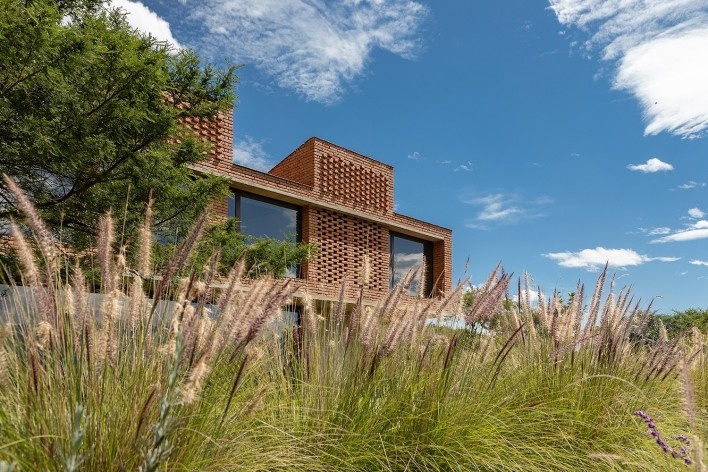
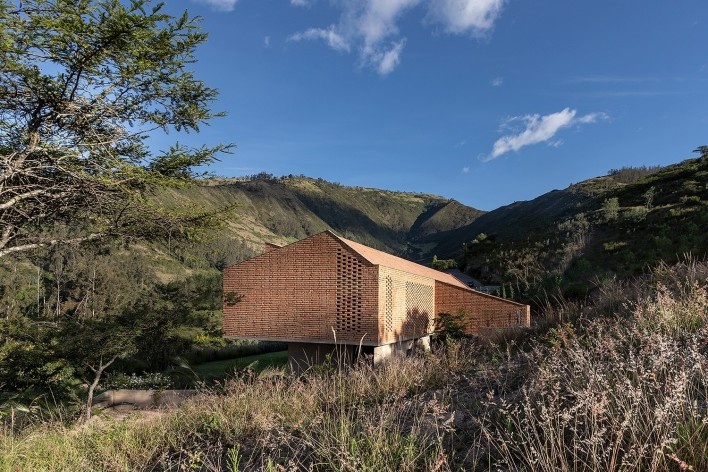










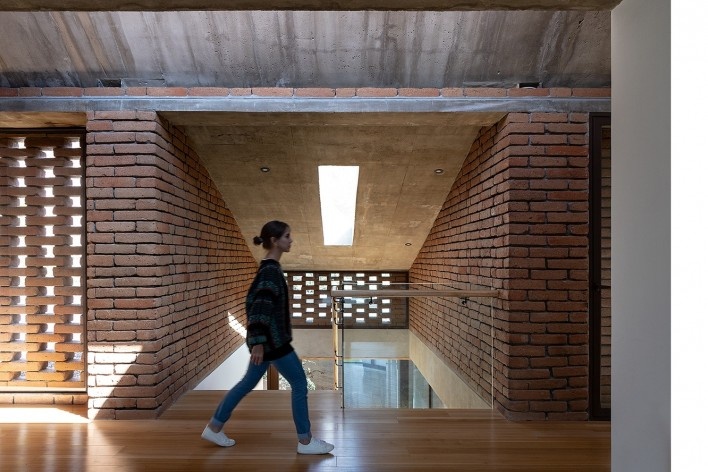



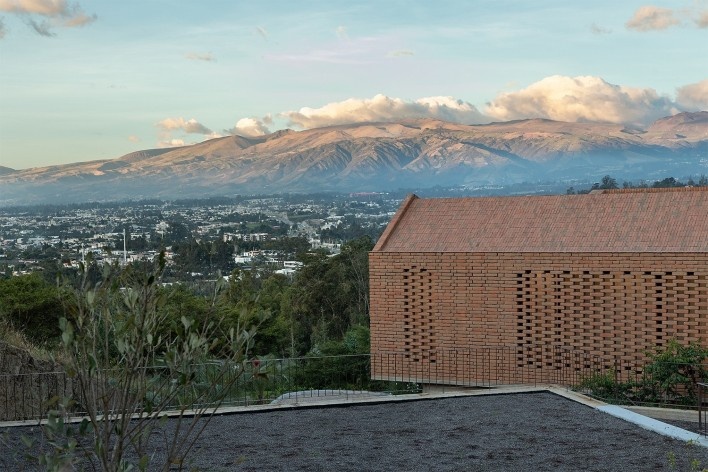

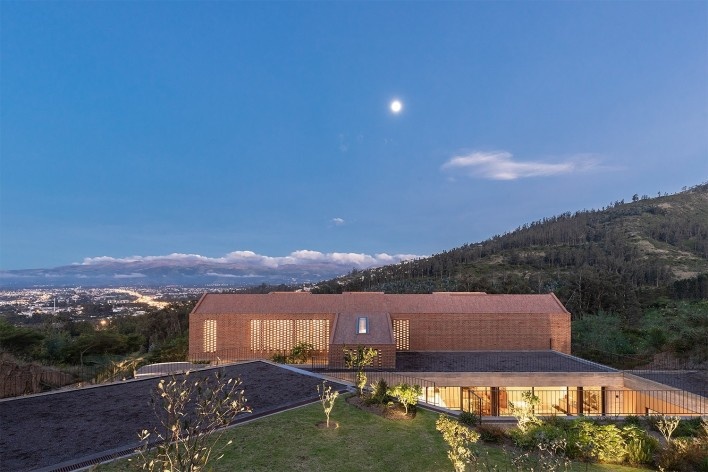
![Cangahua House, ground and upper floor plans, Pacho Salas, Tumbaco, Ecuador, 2020. Architects Felipe Muller, Gonzalo Diez, Paola Picciallo, Alvaro Borrero and Hugo Navarrete (authors) / Diez+ Muller Arquitectos<br />Imagem divulgação/disclosure image/divulgacíon [Diez+ Muller Arquitectos]](https://vitruvius.com.br/media/images/magazines/grid_12/76838288ee57_cangahua27.jpg)
![Cangahua House, rooftop plan, Pacho Salas, Tumbaco, Ecuador, 2020. Architects Felipe Muller, Gonzalo Diez, Paola Picciallo, Alvaro Borrero and Hugo Navarrete (authors) / Diez+ Muller Arquitectos<br />Imagem divulgação/disclosure image/divulgacíon [Diez+ Muller Arquitectos]](https://vitruvius.com.br/media/images/magazines/grid_12/dbe1f7fbb225_cangahua28.jpg)
![Cangahua House, sections, Pacho Salas, Tumbaco, Ecuador, 2020. Architects Felipe Muller, Gonzalo Diez, Paola Picciallo, Alvaro Borrero and Hugo Navarrete (authors) / Diez+ Muller Arquitectos<br />Imagem divulgação/disclosure image/divulgacíon [Diez+ Muller Arquitectos]](https://vitruvius.com.br/media/images/magazines/grid_12/7b0a912b0e6c_cangahua29.jpg)
![Cangahua House, sections, Pacho Salas, Tumbaco, Ecuador, 2020. Architects Felipe Muller, Gonzalo Diez, Paola Picciallo, Alvaro Borrero and Hugo Navarrete (authors) / Diez+ Muller Arquitectos<br />Imagem divulgação/disclosure image/divulgacíon [Diez+ Muller Arquitectos]](https://vitruvius.com.br/media/images/magazines/grid_12/47f2e8e4bead_cangahua30.jpg)






















![Cangahua House, ground and upper floor plans, Pacho Salas, Tumbaco, Ecuador, 2020. Architects Felipe Muller, Gonzalo Diez, Paola Picciallo, Alvaro Borrero and Hugo Navarrete (authors) / Diez+ Muller Arquitectos<br />Imagem divulgação/disclosure image/divulgacíon [Diez+ Muller Arquitectos]](https://vitruvius.com.br/media/images/magazines/gallery_thumb/76838288ee57_cangahua27.jpg)
![Cangahua House, rooftop plan, Pacho Salas, Tumbaco, Ecuador, 2020. Architects Felipe Muller, Gonzalo Diez, Paola Picciallo, Alvaro Borrero and Hugo Navarrete (authors) / Diez+ Muller Arquitectos<br />Imagem divulgação/disclosure image/divulgacíon [Diez+ Muller Arquitectos]](https://vitruvius.com.br/media/images/magazines/gallery_thumb/dbe1f7fbb225_cangahua28.jpg)
![Cangahua House, sections, Pacho Salas, Tumbaco, Ecuador, 2020. Architects Felipe Muller, Gonzalo Diez, Paola Picciallo, Alvaro Borrero and Hugo Navarrete (authors) / Diez+ Muller Arquitectos<br />Imagem divulgação/disclosure image/divulgacíon [Diez+ Muller Arquitectos]](https://vitruvius.com.br/media/images/magazines/gallery_thumb/7b0a912b0e6c_cangahua29.jpg)
![Cangahua House, sections, Pacho Salas, Tumbaco, Ecuador, 2020. Architects Felipe Muller, Gonzalo Diez, Paola Picciallo, Alvaro Borrero and Hugo Navarrete (authors) / Diez+ Muller Arquitectos<br />Imagem divulgação/disclosure image/divulgacíon [Diez+ Muller Arquitectos]](https://vitruvius.com.br/media/images/magazines/gallery_thumb/47f2e8e4bead_cangahua30.jpg)
